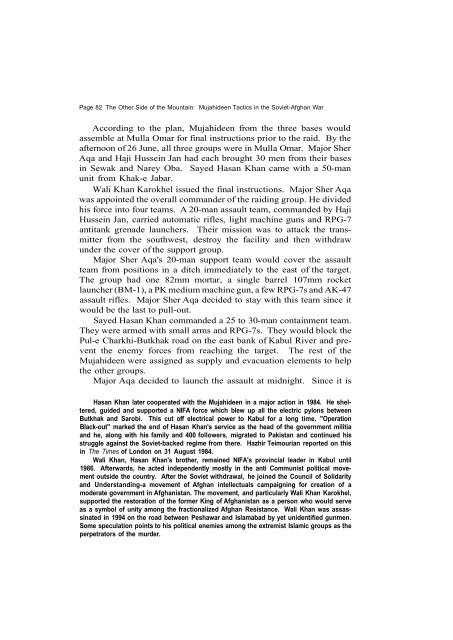Mujahideen Tactics in the Soviet-Afghan War - Bennett Park Raiders
Mujahideen Tactics in the Soviet-Afghan War - Bennett Park Raiders
Mujahideen Tactics in the Soviet-Afghan War - Bennett Park Raiders
You also want an ePaper? Increase the reach of your titles
YUMPU automatically turns print PDFs into web optimized ePapers that Google loves.
Page 82 The O<strong>the</strong>r Side of <strong>the</strong> Mounta<strong>in</strong>: <strong>Mujahideen</strong> <strong>Tactics</strong> <strong>in</strong> <strong>the</strong> <strong>Soviet</strong>-<strong>Afghan</strong> <strong>War</strong><br />
Accord<strong>in</strong>g to <strong>the</strong> plan, <strong>Mujahideen</strong> from <strong>the</strong> three bases would<br />
assemble at Mulla Omar for f<strong>in</strong>al <strong>in</strong>structions prior to <strong>the</strong> raid. By <strong>the</strong><br />
afternoon of 26 June, all three groups were <strong>in</strong> Mulla Omar. Major Sher<br />
Aqa and Haji Husse<strong>in</strong> Jan had each brought 30 men from <strong>the</strong>ir bases<br />
<strong>in</strong> Sewak and Narey Oba. Sayed Hasan Khan came with a 50-man<br />
unit from Khak-e Jabar.<br />
Wali Khan Karokhel issued <strong>the</strong> f<strong>in</strong>al <strong>in</strong>structions. Major Sher Aqa<br />
was appo<strong>in</strong>ted <strong>the</strong> overall commander of <strong>the</strong> raid<strong>in</strong>g group. He divided<br />
his force <strong>in</strong>to four teams. A 20-man assault team, commanded by Haji<br />
Husse<strong>in</strong> Jan, carried automatic rifles, light mach<strong>in</strong>e guns and RPG-7<br />
antitank grenade launchers. Their mission was to attack <strong>the</strong> transmitter<br />
from <strong>the</strong> southwest, destroy <strong>the</strong> facility and <strong>the</strong>n withdraw<br />
under <strong>the</strong> cover of <strong>the</strong> support group.<br />
Major Sher Aqa's 20-man support team would cover <strong>the</strong> assault<br />
team from positions <strong>in</strong> a ditch immediately to <strong>the</strong> east of <strong>the</strong> target.<br />
The group had one 82mm mortar, a s<strong>in</strong>gle barrel 107mm rocket<br />
launcher (BM-1), a PK medium mach<strong>in</strong>e gun, a few RPG-7s and AK-47<br />
assault rifles. Major Sher Aqa decided to stay with this team s<strong>in</strong>ce it<br />
would be <strong>the</strong> last to pull-out.<br />
Sayed Hasan Khan commanded a 25 to 30-man conta<strong>in</strong>ment team.<br />
They were armed with small arms and RPG-7s. They would block <strong>the</strong><br />
Pul-e Charkhi-Butkhak road on <strong>the</strong> east bank of Kabul River and prevent<br />
<strong>the</strong> enemy forces from reach<strong>in</strong>g <strong>the</strong> target. The rest of <strong>the</strong><br />
<strong>Mujahideen</strong> were assigned as supply and evacuation elements to help<br />
<strong>the</strong> o<strong>the</strong>r groups.<br />
Major Aqa decided to launch <strong>the</strong> assault at midnight. S<strong>in</strong>ce it is<br />
Hasan Khan later cooperated with <strong>the</strong> <strong>Mujahideen</strong> <strong>in</strong> a major action <strong>in</strong> 1984. He sheltered,<br />
guided and supported a NIFA force which blew up all <strong>the</strong> electric pylons between<br />
Butkhak and Sarobi. This cut off electrical power to Kabul for a long time. "Operation<br />
Black-out" marked <strong>the</strong> end of Hasan Khan's service as <strong>the</strong> head of <strong>the</strong> government militia<br />
and he, along with his family and 400 followers, migrated to Pakistan and cont<strong>in</strong>ued his<br />
struggle aga<strong>in</strong>st <strong>the</strong> <strong>Soviet</strong>-backed regime from <strong>the</strong>re. Hazhir Teimourian reported on this<br />
<strong>in</strong> The Times of London on 31 August 1984.<br />
Wali Khan, Hasan Khan's bro<strong>the</strong>r, rema<strong>in</strong>ed NIFA's prov<strong>in</strong>cial leader <strong>in</strong> Kabul until<br />
1986. Afterwards, he acted <strong>in</strong>dependently mostly <strong>in</strong> <strong>the</strong> anti Communist political movement<br />
outside <strong>the</strong> country. After <strong>the</strong> <strong>Soviet</strong> withdrawal, he jo<strong>in</strong>ed <strong>the</strong> Council of Solidarity<br />
and Understand<strong>in</strong>g-a movement of <strong>Afghan</strong> <strong>in</strong>tellectuals campaign<strong>in</strong>g for creation of a<br />
moderate government <strong>in</strong> <strong>Afghan</strong>istan. The movement, and particularly Wali Khan Karokhel,<br />
supported <strong>the</strong> restoration of <strong>the</strong> former K<strong>in</strong>g of <strong>Afghan</strong>istan as a person who would serve<br />
as a symbol of unity among <strong>the</strong> fractionalized <strong>Afghan</strong> Resistance. Wali Khan was assass<strong>in</strong>ated<br />
<strong>in</strong> 1994 on <strong>the</strong> road between Peshawar and Islamabad by yet unidentified gunmen.<br />
Some speculation po<strong>in</strong>ts to his political enemies among <strong>the</strong> extremist Islamic groups as <strong>the</strong><br />
perpetrators of <strong>the</strong> murder.




